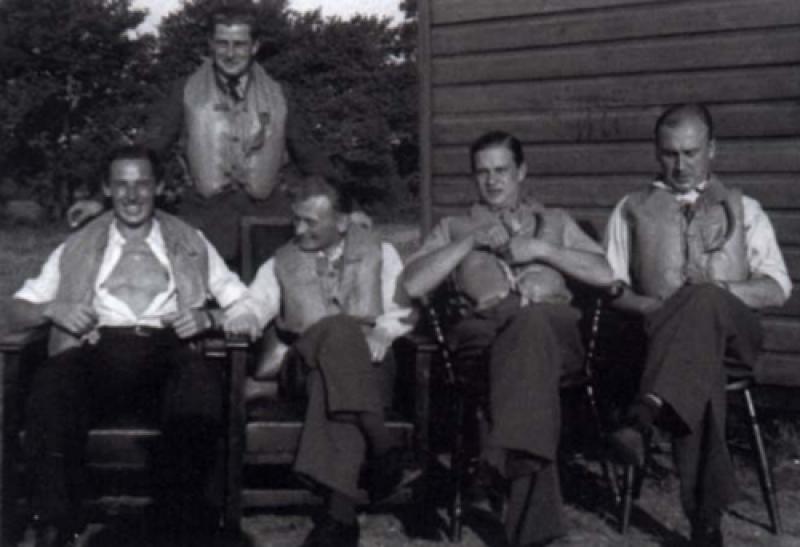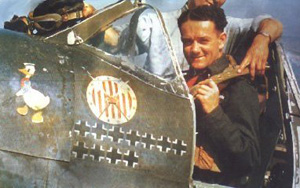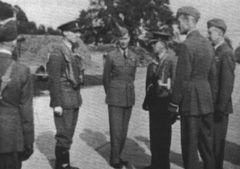


The part played by Polish fighter pilots during the Battle of Britain has hardly gone undocumented, and the Hun-zapping exploits of the Polish 303 Squadron will be familiar to anyone with a historical interest in the subject, so you’d have to say that calling this film The Untold Battle of Britain was a wee bit of an exaggeration.
Those sequences didn’t reappear in The Untold…, though several other dollops of the movie did, featuring Spitfires, Hurricanes, Heinkels and those famously not-quite-right-looking Messerschmitt 109s. Slightly questionable, surely, to shove uncredited lumps of a fictional (albeit factually based) movie into a supposedly historical story, though I suppose it’s a measure of the way the movie has been absorbed into our Island Story and granted a kind of honorary degree in authenticity.
 Anyway, as the nation celebrates the 70th anniversary of the Battle of Britain this summer, who could deny that the story of the heroic Polish pilots deserves wider exposure? With poignant timing, 303 squadron became fully operational on 31 August, 1940 - the first anniversary of the German invasion of Poland. Having been shredded by the superior machinery of the Luftwaffe over their home turf, many of the Polish pilots had then fought in France as the Blitzkrieg thundered towards the English Channel (picture above right: Lt Jan Zumbach of 303 Squadron). That didn’t go too well either, but finally the Battle of Britain offered them the chance to hit back at Jerry on more equal terms. Even though they were equipped with Hurricanes rather than the more glamorous but less numerous Spitfires, they tore into the huge German formations with malice palpably aforethought, almost welcoming the Germans’ numerical superiority because it gave them more targets to shoot at. Where home-grown pilots might start firing at the enemy when they were 400 yards away, the Poles reckoned 100 yards was about right – if you got that close, your quarry became quite difficult to miss. As British pilot Billy Drake commented, while the Brits merely wanted to shoot down the German aircraft, “the Poles wanted to kill anybody that was in those aeroplanes.”
Anyway, as the nation celebrates the 70th anniversary of the Battle of Britain this summer, who could deny that the story of the heroic Polish pilots deserves wider exposure? With poignant timing, 303 squadron became fully operational on 31 August, 1940 - the first anniversary of the German invasion of Poland. Having been shredded by the superior machinery of the Luftwaffe over their home turf, many of the Polish pilots had then fought in France as the Blitzkrieg thundered towards the English Channel (picture above right: Lt Jan Zumbach of 303 Squadron). That didn’t go too well either, but finally the Battle of Britain offered them the chance to hit back at Jerry on more equal terms. Even though they were equipped with Hurricanes rather than the more glamorous but less numerous Spitfires, they tore into the huge German formations with malice palpably aforethought, almost welcoming the Germans’ numerical superiority because it gave them more targets to shoot at. Where home-grown pilots might start firing at the enemy when they were 400 yards away, the Poles reckoned 100 yards was about right – if you got that close, your quarry became quite difficult to miss. As British pilot Billy Drake commented, while the Brits merely wanted to shoot down the German aircraft, “the Poles wanted to kill anybody that was in those aeroplanes.”
They achieved this with merciless efficiency. Historians and statisticians have made subsequent revisions of the numbers, but according to the programme, it took less than a month for 303 Squadron to record its 100th “kill”. The squadron shot down six German aircraft on its first official combat sortie, and on 7 September 1940, 303 shot down 16 planes in less than 15 minutes. Józef František, a Czech pilot flying with the Poles, was credited with 17 kills and was the highest-scoring Allied ace in the Battle of Britain.
 The English girls loved the Poles, the newspapers raved about their exploits, and King George VI visited them at their Northolt base and signed his name in the squadron diary (the royal visit, pictured left). But this programme was part of a series called Bloody Foreigners, and there was a bitter sting to the tale. The Polish flyers thought they were fighting for their own post-war freedom, only to find that the Western allies had sold them out to Stalin at the Yalta conference. Pilots who returned home were liquidated by Poland’s new Communist administration. When the British held a huge multi-nation victory parade in London in 1946, the Poles weren’t invited because apparently our government was afraid of upsetting Stalin. “We watch with sorrow the strange outcome of our endeavours,” said Winston Churchill. “Strange” doesn’t seem quite adequate, somehow.
The English girls loved the Poles, the newspapers raved about their exploits, and King George VI visited them at their Northolt base and signed his name in the squadron diary (the royal visit, pictured left). But this programme was part of a series called Bloody Foreigners, and there was a bitter sting to the tale. The Polish flyers thought they were fighting for their own post-war freedom, only to find that the Western allies had sold them out to Stalin at the Yalta conference. Pilots who returned home were liquidated by Poland’s new Communist administration. When the British held a huge multi-nation victory parade in London in 1946, the Poles weren’t invited because apparently our government was afraid of upsetting Stalin. “We watch with sorrow the strange outcome of our endeavours,” said Winston Churchill. “Strange” doesn’t seem quite adequate, somehow.
Links
[1] https://theartsdesk.com/users/adam-sweeting
[2] https://www.addtoany.com/share_save
[3] http://www.amazon.co.uk/Battle-Britain-Definitive-Laurence-Olivier/dp/B000M3421I/ref=sr_1_1?ie=UTF8&s=dvd&qid=1277853349&sr=1-1
[4] http://www.amazon.co.uk/Battle-Britain-Definitive-Laurence-Olivier/dp/B000M3421I/ref=sr_1_1
[5] https://theartsdesk.com/tv
[6] https://theartsdesk.com/topics/poland
[7] https://theartsdesk.com/topics/world-war-two
[8] https://theartsdesk.com/topics/stalin
[9] https://theartsdesk.com/topics/hitler
[10] https://theartsdesk.com/topics/channel-4
[11] https://theartsdesk.com/topics/history
[12] https://theartsdesk.com/topics/reviews